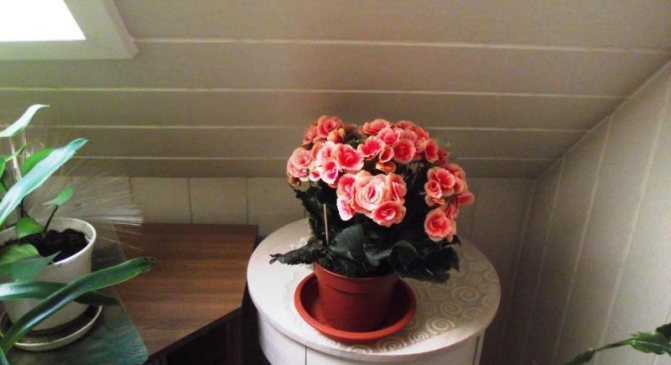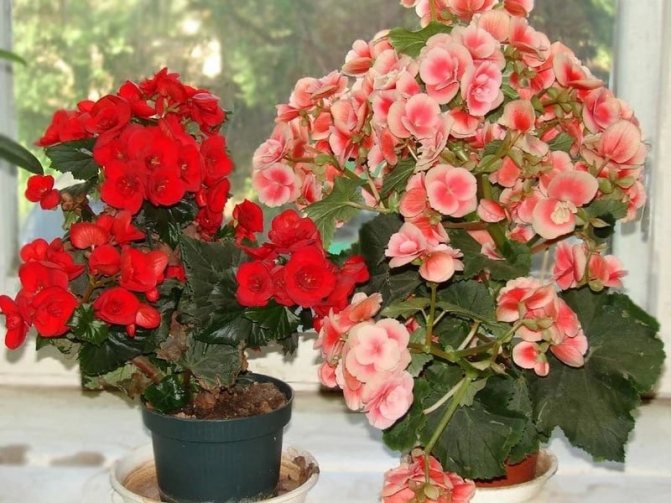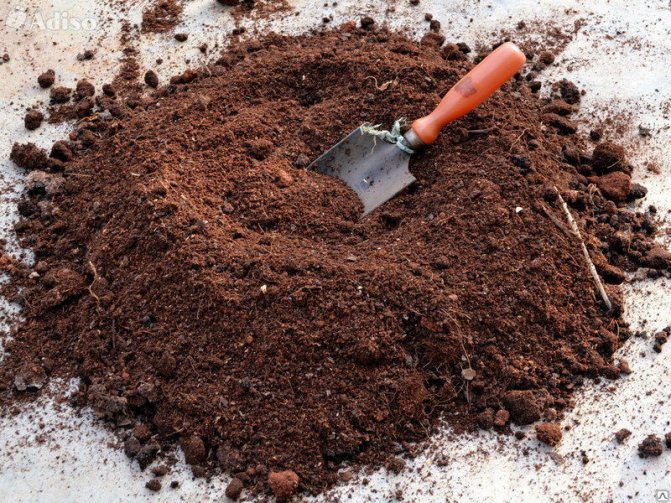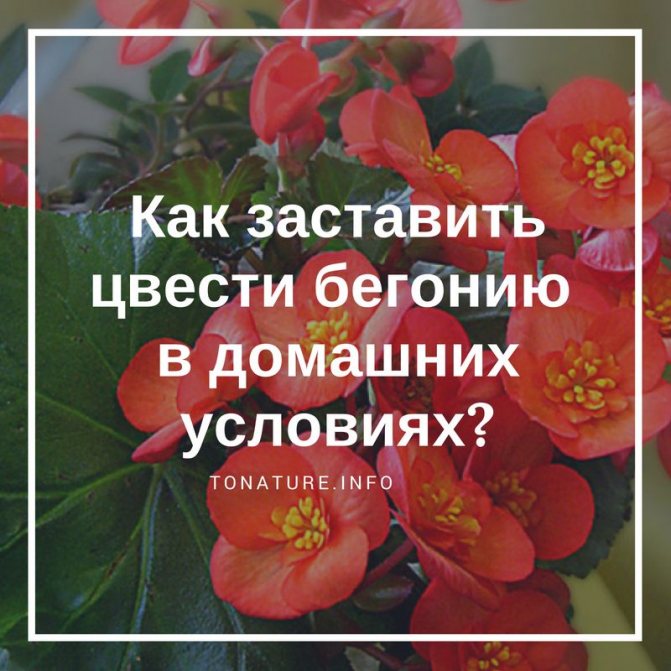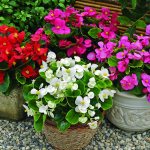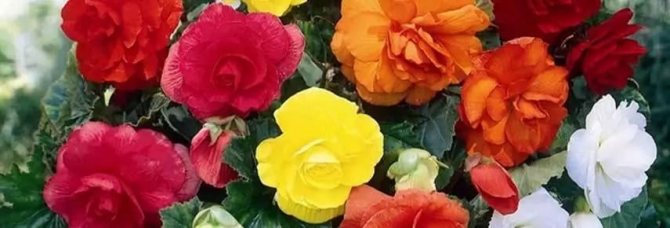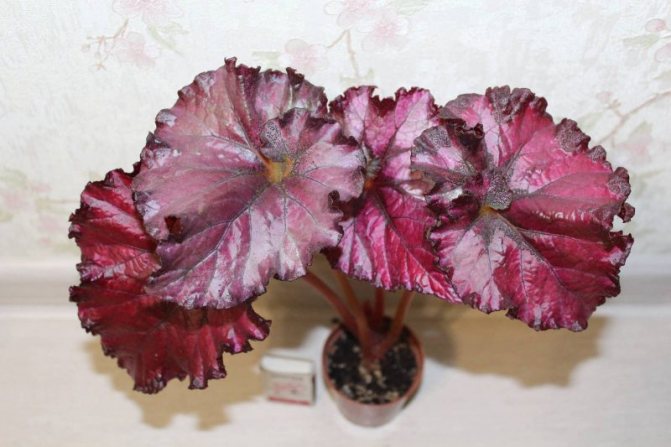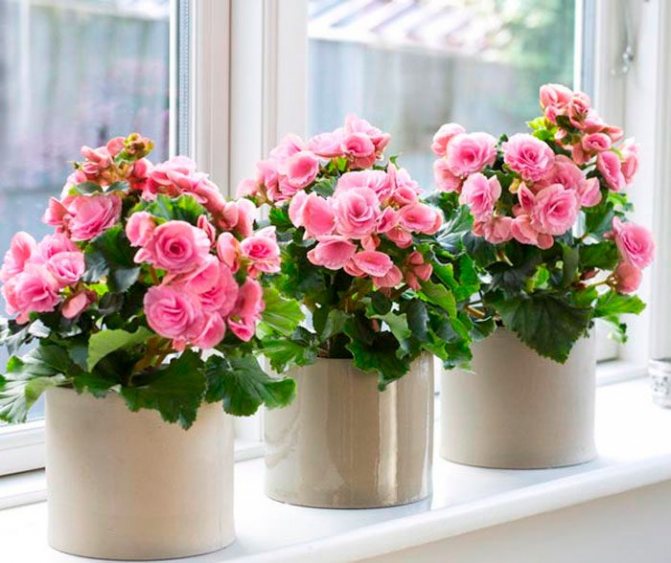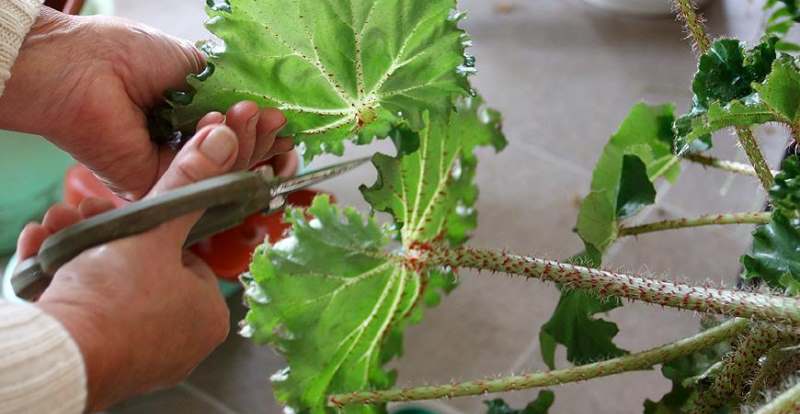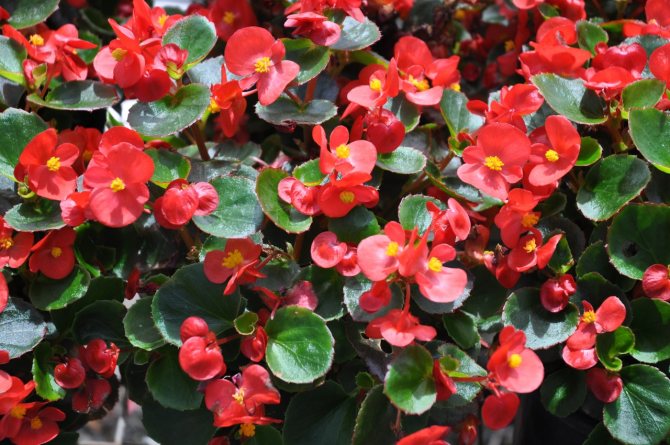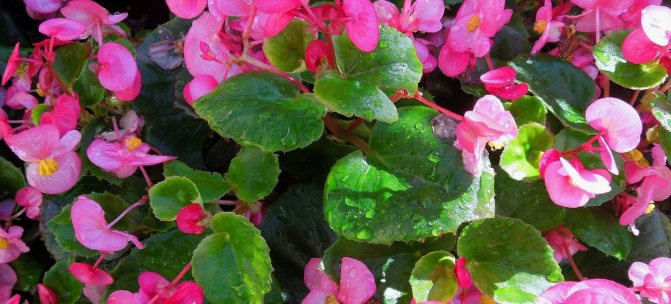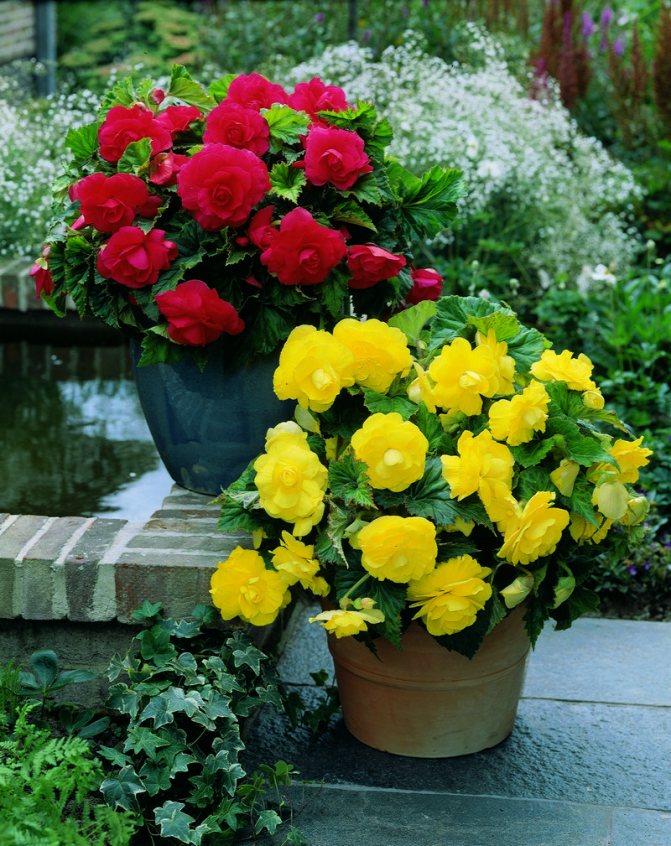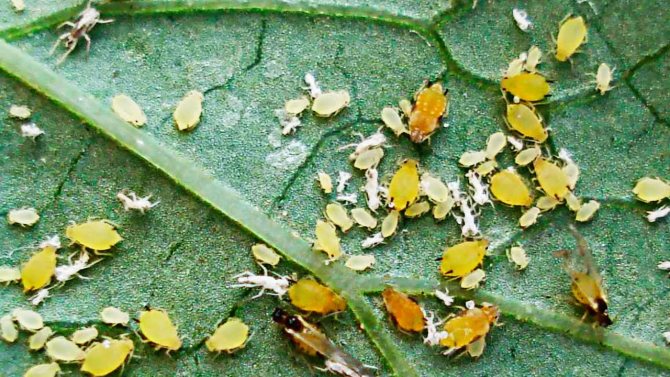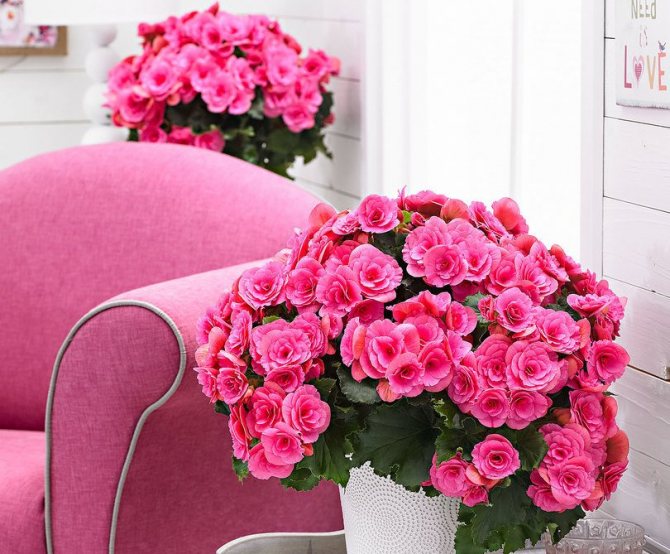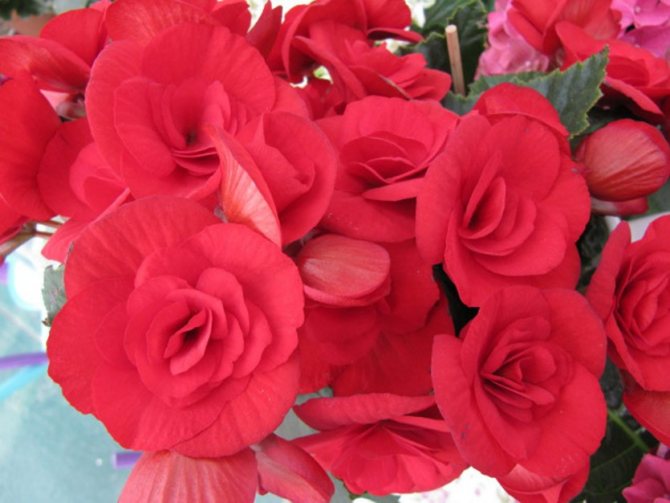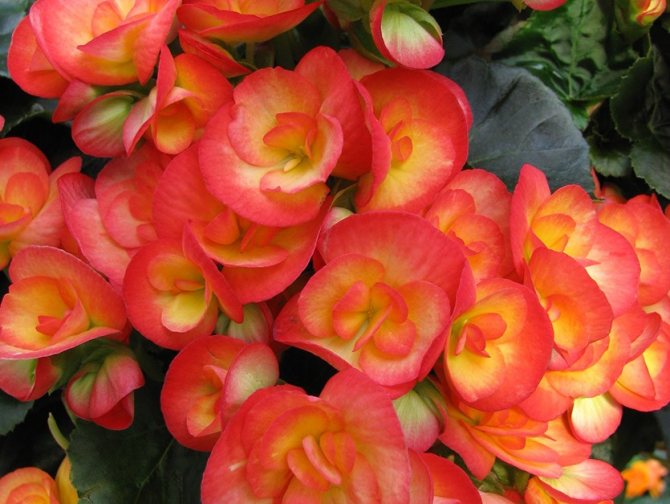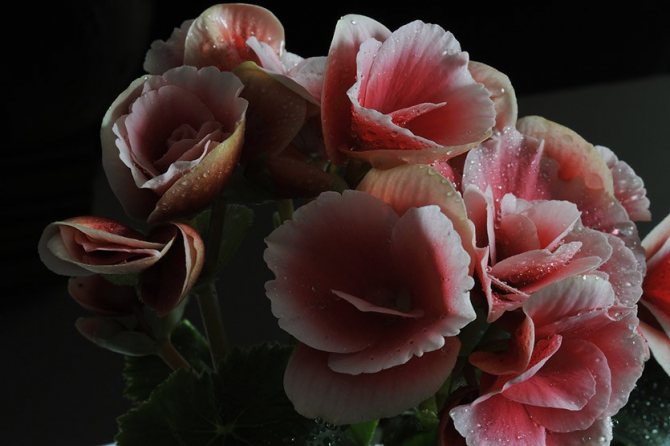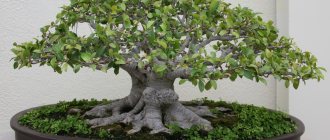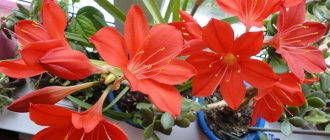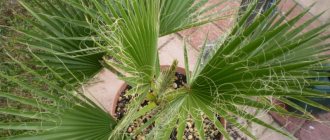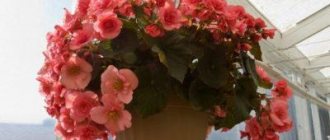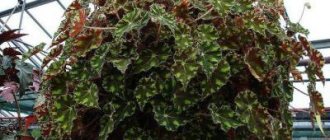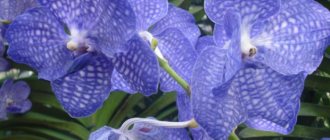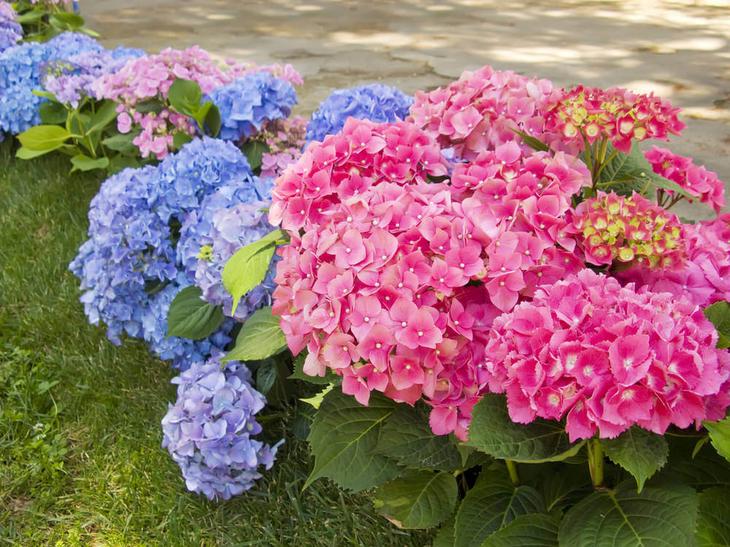
Begonia is a bright and beautiful member of the begonia family. It is not for nothing that the begonia flower is often called the most popular plant among flower growers. How to care for her at home - worries many. Begonia has many perennial and annual species of shrubs, grasses and dwarf shrubs. Due to this, it is easy to choose a flowering houseplant just for yourself.
What it is?
Begonia is a bright plant of the Begoniev family... Many annual and perennial grasses, dwarf shrubs and shrubs are known. Begonia leaves are asymmetrical, whole or split into several lobules with jagged or wavy edges. The inflorescence is complex, includes female and male flowers. The color of the flowers is varied: white, yellow, pink, red, orange. Contrasting edging is possible along the edge of the petals.
The fruit is a triangular box with small seeds. The root system of begonias can be tuberous, rhizome and branched. Tuberous begonia grows not only at home, but also in the garden. The rest of the species are grown exclusively indoors.
Types and varieties of begonias
Homemade begonias can be divided into two groups: a deciduous variety and a flowering one. In deciduous varieties, the color of the leaves is very original, while the shape is quite unusual. And flowering specimens can be divided into evergreen, bushy and tuberous plants.
Popular varieties:
- Tuberous variety. Double petals of flowers, quite simple, but of different colors: from bright white to orange and red. The petals can combine two colors, and they can be framed by a border. The size of the inflorescences can be small (five centimeters) or reach eighteen centimeters. They resemble carnations, peonies, roses in shape.
- Royal grade. Deciduous specimen. The leaves are shaped like a heart, and can be up to thirty centimeters long. Reds, browns and greens are both delightful and striking at the same time.
- Eternal flowering variety. A very common species related to a bushy plant. It is usually grown as a horticultural crop, but you can also grow it at home. Flowering can occur all year round. Glossy green and red leaves. The flowers are small, but bright - pinkish, white, red.
- Elatior. Designed for home cultivation. Tuberous hybrid. Flowering begins in autumn. The petals differ in their shades, the leaves are rounded.
- Ampel subspecies. It resembles ivy, covered with small flowers of yellow, white, orange or ruby color. Hanging garlands of such begonias will delight you with their flowers throughout the growing season.
Popular varieties of begonias
The soil
One of the main conditions for the normal development of indoor begonias is the correct soil. Only in a well-chosen soil is a healthy formation of the root system possible. The nutrition of the plant depends on the soil mixture. Different types have their own characteristics and require an individual approach to the composition of the soil.
The root system of the plant is weak, very sensitive to excess moisture in the soil. Begonias need a loose nutrient substrate, well permeable to air and moisture. The reaction of the soil is slightly acidic, the pH level should be in the range from 5.5 to 6.5.You can buy ready-made special soil or independently form a soil mixture consisting of leafy soil, peat, sand and compost.
For the outflow of excess moisture, it is imperative to use drainage: expanded clay or fine gravel.
Growing problems
It often happens that begonia does not want to bloom. This problem occurs when:
- insufficient lighting;
- improperly selected soil;
- wrong transplant;
- not timely fertilization;
- lack of a rest period;
- too dry air;
- damage by pests;
- strong overdrying of the soil or watering with hard water.
In order for begonia to bloom again, growing conditions must be changed.
Sometimes begonia cannot bloom due to age or an improperly planted plant species. If the shrub does not bloom, it may be a cultivar with decorative leaves. Ornamental leafy begonias have beautiful leaves of large or small sizes, with an exquisite shape and pattern. Often the stems of such plants are creeping, and the foliage rises high on elongated cuttings. Decorative deciduous begonias do not bloom, but there are varieties of this species that bloom very little with small flowers.
Optimal mix
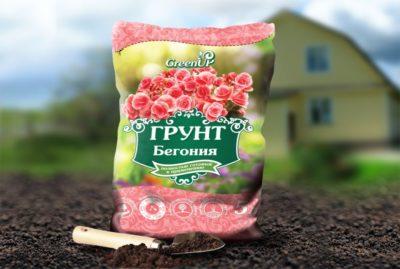

What land is needed for planting? The best option for begonias is a mixture that includes the following composition:
- leaf land - 2 parts;
- peat - 2 parts;
- sand - 1 part;
- compost - 1 part.
To make the soil loose, you need to use vermiculite, coconut fiber, perlite and other leavening agents. Lime or dolomite flour will reduce the acidity of the soil... Before preparing the soil at home, sift the soil, remove large inclusions.
Leafy soil taken in a park, forest or garden may contain microorganisms that are dangerous to the plant, which can become the culprits of various diseases. The soil must be disinfected: calcined in the oven or scalded with boiling water. Expanded clay or gravel should be placed at the bottom of the pot at ⅓ of the height.
general description
This plant is familiar to many, but not everyone knows how many varieties of begonias exist. To begin with, there are deciduous ornamental species that are valued for the beauty of their leaves. The color of these plants is simply amazing: red, pink, purple, gray, almost black, various combinations of greenery, with contrasting edging, and a fancy pattern. The shape of the leaf is irregular, resembling an inverted blob, a circle with a wavy edge, or a maple leaf. The stems are fleshy, thick.
In this article, we will talk about another variety - flowering begonias. This plant has turned out to be at its best here: red, yellow, purple, pink and white small flowers are literally strewn with compact bushes.
The natural habitat of these wonderful flowers is South America, Asia and Africa. Belong to the begonias family, they have more than 1000 varieties. Named after the Governor of Haiti, Michel Begon the Elder, who lived in the 17th century, when the genus of begonias was discovered.
Preparing for planting - choosing a pot
For planting, you need to prepare the correct flowerpot for begonias. Cuttings that have already begun to take root are seated in containers with a diameter of 5-6 centimeters. After about 6 months, the plants are transplanted into flowerpots 8-10 centimeters in size. The exact size is determined based on the size of the overgrown roots. Begonias prefer small containers, 3-4 centimeters in diameter larger than the root system.
In too large pots, plants later form buds... In addition, there is a risk of root rot from excess moisture. The diameter of the container should slightly exceed the height. A prerequisite is the presence of a drainage hole at the bottom of the pot.
The optimal material for the flowerpot is ceramics. Such a pot protects against waterlogging, has excellent thermal insulation, and provides air exchange.The use of a plastic container is allowed. In this case, it is necessary to provide the correct substrate, organize good drainage and avoid hypothermia or overheating.
Errors and their consequences
If, when feeding plants, you do not adhere to the specified norms for certain agents, then such negligence can have a number of consequences:
- If the plant is overfed, it may die.
- Plant oversaturation with organic or mineral fertilizers can lead to death, it is imperative to alternate fertilizers.
- If the plant is just planted or transplanted, it cannot be fed for a month, a fragile seedling can slow down the development of the root system.
- If the plant is sick, feeding it must be done carefully and start with small doses, since in case of disease the roots of the plant are weakened and it can perceive nutrients as a destructive component.
- Top dressing during flowering or dormancy can destroy the plant.
How to transplant?
The best period for transplanting begonia is early spring., before the beginning of the growing season. At this time, the plant tolerates this procedure more easily and is easier to recover. A begonia transplant is carried out when the roots become cramped in the pot and they begin to show up from the drainage holes.
The transplant can be full or partial. A complete transplant is required after acquiring a new plant, as well as when begonia is affected by diseases or pests. Sequencing:
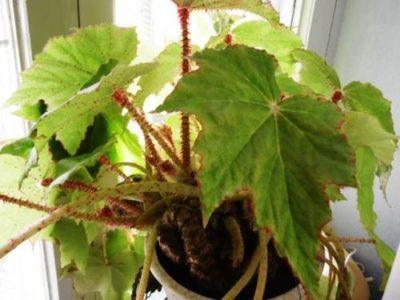

Prepare the pot.- Place a layer of expanded clay on the bottom of the pot.
- Pour a small layer of charcoal to protect the roots from rot.
- Cover the drainage layer with soil 2 centimeters.
- Water the begonia well.
- Wait an hour. Then carefully remove the plant from the pot.
- Gently shake off the roots from the old earth, inspect.
- Dip the roots in a solution of potassium permanganate, the color of which should be light pink.
- Gently rinse the roots with settled water.
- Examine the root system, cut off damaged and decayed areas.
- Place the begonia in a new pot.
- Cover the roots with prepared soil. The root collar should not be too deep. It is necessary to allow the roots to dry, only then completely cover with soil.
It is not recommended to compact the substrate; after watering, the soil will settle well by itself. If the upper part of the root system is then exposed, you need to add a little earth.
Transplanting a healthy begonia into a larger pot is done in a gentle way. Partial transplant in progress:
- Remove the begonia from the old flowerpot.
- Place the plant together with the earthy clod in a new pot, filling the empty spaces with fresh soil.
Young plants accept this procedure quite well. Transplanting adult specimens is complicated by the presence of a large number of fragile leaves. Plants that have reached the age of three are divided into several parts.
Flowering features
Many growers plant a crop at the end of February, so that the first buds form at the end of April, and flowering begins in May.
Reference. With proper care, begonias are covered in flowers all year round.
When does it dissolve and how long does it take?
The flowering time is influenced by a number of factors:
- Variety. Simple flowers bloom longer than large-flowered ones.
- Growing method. When the culture is in the open field, flowering is limited by the time frame due to weather conditions. There are varieties of ever-flowering begonias, which, after transplanting from a garden to a pot, are strewn with flowers until spring (you can read about recommendations for caring for annual and perennial begonias here).
- Root system type. Begonias are of two types: with a regular and tuberous system. The first ones bloom almost all year round. The second ones are dug up for the winter.
If the culture does not provide the necessary conditions and care, flowering will be brief or not at all (you can learn about why begonia does not bloom and how to achieve beautiful buds here, and how to grow this plant healthy and beautiful is described here). When the plant is dormant, the ability to bloom depends on when and how the awakening measures are correctly taken. Usually this is done in February, and by May the first flowers appear.
What happens during bud opening?


Begonias bloom brightly and profusely. The flowers resemble peonies, roses and carnations. They are simple, terry, large and small.
Flowers are collected in axillary racemose inflorescences that form on the tops of the shoots. The perianth consists of 2-5, and even 7-8 flowers.
For begonias, heterosexual flowers are characteristic. There are women with pistils, men with stamens. Some double male inflorescences may not have stamens. On the back of the female flowers there is a bulge from which the seed capsule is formed. Male flowers have nothing. Read about the signs of male flowers on the plant, as well as about the beautiful flowering varieties of begonias, read our material.
Important! If you remove female flowers from the moment of their formation, the culture will bloom longer and more intensely. The procedure is done if you do not need to collect seeds.
Processes occurring with begonia during flowering:
- From the beginning of awakening, strength and nutrients accumulate.
- Buds are formed, reproductive organs are formed.
- After the plant is ready for reproduction, male flowers bloom, then female ones.
- If pollination takes place, the male flowers wither. In women, boxes with seeds ripen.
During this period, begonias need trace elements and nutrients in large quantities. More water, heat and sunlight is required.
Watering and feeding
Begonia loves water. When watering, it is recommended to adhere to the following rules:
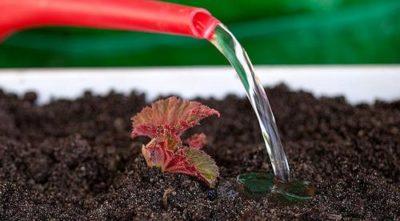

For irrigation, water at room temperature that has been settled during the day is used.- A drainage system should be organized at the bottom of the flowerpot.
- Moistening is required when the soil is dry to a depth of 1.5 centimeters.
- From the end of November to March, it is required to reduce watering to once a week. Tuberous species enter dormancy and are kept in peat, watering is completely stopped.
- Since March, the intensity of moisture is gradually increasing.
- In summer, it is necessary to moisten the ground so that excess water flows out through the drainage hole. After a while, drain the remaining moisture from the pallet. The frequency of the procedure is 2 times a week.
- In extreme heat, daily watering is required.
- From October, watering is necessary as the topsoil dries up.
- It is important to avoid stagnant moisture that causes root decay.
From the moment the first buds appear on the begonias, it is necessary to begin the feeding process. When choosing fertilizers, you should take into account the type of plant.... Deciduous begonias prefer nitrogen supplements such as:
- Kemir: dilute half of the package in 10 liters of water.
- Uniflor-growth: dissolve 5 milliliters of the drug in 2 liters of water.
- Agricole: Dilute 5 grams of product in 2 liters of water.
Flowering varieties require potassium-phosphorus fertilizers to stimulate and maintain flowering. Top dressing such as Bud, Ovary, Pollen, Zdraviya are suitable. Funds are diluted in 1-2 grams per liter of water.
Fertilizer is added to the soil during flowering once every 15 days. As soon as the plant has faded, feeding must be stopped. In winter, the plant is dormant, no fertilizers are applied.
When growing begonias, certain rules must be followed. It is important to form a loose nutritious soil, create good drainage, choose a suitable pot, organize the correct watering and feeding regime.All these measures will help preserve the health and beauty of begonias.
If you find an error, please select a piece of text and press Ctrl + Enter.
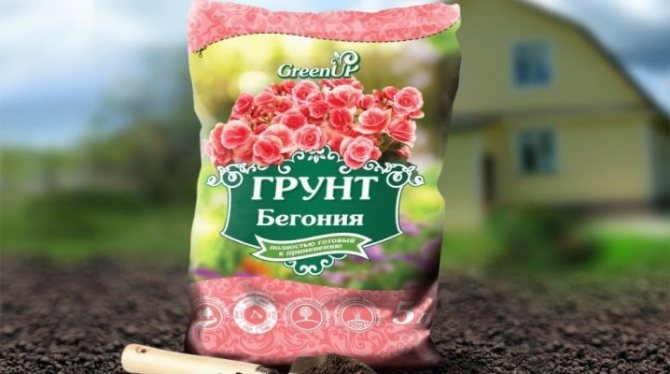

Begonia is a popular houseplant with about 1,000 varieties and twice as many hybrids. It does not require complex maintenance and has high decorative qualities. In nature, begonia is widespread in tropical rainforests and high mountain areas. Most often it can be found in places with a suitable climate, among them - India, Sri Lanka, South America and the Eastern Himalayas.
Florist's actions after the cessation of flowering: general rules
1. A withered flower is removed immediately by cutting or twisting. Thus, the plant retains the strength for the development of other buds.


2. When flowers are over-pollinated and fruits are formed, only a few should be left. Begonia can be planted from seeds ripened in a box.
Florist's actions after flowering stops: tuberous species
1. Reducing watering.
2. Pruning leaves, shoots.
3. Reduction of light (the plant is placed in a dark place).
4. Digging out the tuber from the ground after the drying of the above-ground plant part.
5. Inspection of tubers, their pruning and dusting with coal in case of detection of rot.
6. Packing tubers in a bag, determination for storage in a cold place.
What role does the right soil play?
Despite the unpretentiousness of begonias, the composition of the soil and its structure play a decisive role in the well-being of the plant. From the soil, the root system delivers nutrients to the leaves and flowers. If it does not contain enough trace elements, the plant will lose its decorative properties - the flowers will fade, and the leaves will change color. In addition, begonia will become vulnerable to diseases such as gray mold and bacterial mottling. If emergency measures are not taken in this situation, the begonia will die.
The pH level plays an important role in the proper development of the plant. With excessive acidity of the soil, the substances necessary for proper development are less assimilated and the growth of roots slows down. Begonia is naturally characterized by a weak root system, so it is easier for it to survive an insufficient acidity level than an increased one. This is also explained by the fact that the roots of the plant are able to emit carbon dioxide, naturally raising the pH to the desired level.
The composition of the soil for different types of begonias may differ. So, for its blooming form, ingredients are needed that contribute to the formation of buds and prolonged flowering, and for a decorative leafy one, elements are needed that provoke the growth of green mass.


Begonia can grow in moist rainforest soils, on tree roots, or in rock crevices. Long-term selection made it possible to breed various varieties that differ in appearance, root system and growth period, which people began to grow in gardens, summer cottages and residential premises.
No matter where you land, soil for begonia must be nutritious, have good aeration and proper drainage conditions. This article discusses how to create the optimal earthen mixture for growing flowers at home.
Brief description of the plant
Begonia is different, there are varieties of herbaceous plants that do not exceed three centimeters, as well as shrubs with rather high branches.
Some begonias have no stem or only one leaf. The foliage of the plant is green, on the reverse side it is covered with a solid color or specks and patterns.
It blooms with bright flowers, different warm shades. Flowers in their appearance resemble rose petals or carnations. Flowering occurs in early summer and continues until autumn. Indoor begonia blooms longer than a plant growing outdoors. The home flowerpot blooms from May to late autumn.
Soil for begonias
One of the main conditions for the health and good growth of any indoor plant is the selection of the correct soil for the pot. The flower is distinguished by a root system formed by numerous adventitious roots that quickly absorb moisture. The roots are located mainly in the upper layers of the soil. Basically, they grow in breadth, and not in depth. For this reason soil for begonia should:
- have a loose structure;
- it is good to pass water;
- have a slightly acidic reaction;
- contain organic inclusions.
The pH level of the soil for begonias should not exceed 5.5-6.5, should not be too dense and not contain clay. You can prepare the land yourself by collecting the necessary components in the forest or in the country. But if there is no possibility, then in this case you can buy an earthen mixture with an optimally selected composition in a specialized store.
The necessary composition of the soil for begonia
Optimally suitable soil for begonia contains turf, coniferous or leafy soil, high or low-lying peat, coarse sand, expanded clay or fine gravel. Be sure to supplement the soil with organic compost and fertilizers. Experts advise adding slightly rotted, but not excessively rotten humus.
To make the soil loose, vermiculite or perlite is introduced into it. Excess acidity will help reduce lime, charcoal, or dolomite flour. Of course, when preparing the soil for begonias, they do not collect the soil under the trunks of trees, whose fallen leaves contain tannins that are harmful to flowers. These include, for example, oak.
Plant protection from diseases and pests
A favorite plant can get sick, start dropping buds and leaves. This can be evidence of improper care and cultivation errors. It needs to be watched very carefully. Look closely at the beautiful flower:
- If the leaves turn brown and begin to fall off, then the begonias do not have enough moisture in the air and water.
- Fading leaves are a sign of a lack of light.
- Fungus can form on the bush due to low temperature and excessive moisture. The fungus infects shoots and leaves. If you notice this attack, then immediately treat the bush with fungicides.
- Powdery mildew appears due to changes in temperature and dry air. You may notice white bloom on the foliage. Treat the diseased bush with colloidal sulfur.
- But the main pests for this beautiful flower are aphids and spider mites. These parasites are located on the leaves on the back side, taking all the vital juices from them. Get rid of them by spraying with a solution of tobacco and soap. With aphids, special preparations, for example, feverfew, fight well.
In order for begonia to repay you with kindness for caring, follow all the rules for caring for it. After all, if you familiarize yourself with all the features of the plant, then there should be no problems with leaving. The flower, in return, will not only delight you with its blooming appearance: it will purify the surrounding air from toxins, pollution, dust, chemicals. Therefore, so often it can be found on the windowsills of an apartment or private houses: begonia is able to make the abode of its owner safe and clean. Therefore, do not hesitate and do not be afraid of difficulties in care - the plant is perfect for the home.
How to make begonia soil at home
There are several rules for collecting different types of soil for planting begonias at home. Leafy or coniferous trees are harvested in the park, in the forests, in the garden with deciduous trees and shrubs. A well-lit place is chosen, located under the crowns with healthy leaves. The topsoil is carefully removed from the fallen and not overripe last year's foliage, which has a characteristic smell and texture.
For sod land, it is better to go to a clearing or meadow, which are covered with low grass, are far enough from industrial facilities and a dusty highway, and the area itself has no signs of swampiness. The best option would be to collect soil from the mound of the dug wormhole. Otherwise, the collection of sod is done with a sapper shovel or a small bayonet shovel. The thickness of the removed mass containing greens and roots of meadow grasses should not exceed a height of 15 cm.
Soil for begonia
If you look at the recipe in the context of the combination of the constituent parts with the material used, then there are several of the most common types of substrate compositions:
- A mixture for rooting cuttings is created from river sand and crushed peat in a one-to-one combination.
- For germination of tubers, perlite, sphagnum moss and earth from under deciduous trees in an equal number of parts will be a good compound. The soil can be composed of river sand, leafy earth, mixed with turf in a ratio of 2: 2: 1.
- Young shoots of begonias are planted in containers filled with a mixture of soil and peat in a 1: 1 ratio.
- For mature plants, a substrate that combines soil, peat and sand is suitable.
- If you need to transplant flowers, then the best option for Royal Begonia is a combination of turf, leaf, humus and peat in an amount of 1: 2: 2: 2.
- Earthen mixture for Eternal Begonia is made up of leafy earth, peat, river sand, humus, mixed in a ratio of 2: 1: 1: 1.
27
What to do with the plant next?
What to do with the plant depends on the type of root system (you can find out about the types of begonias and its root systems here).
Tuberous
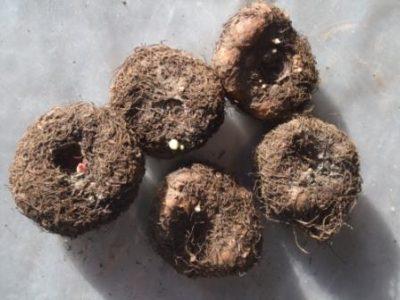

If the begonia is tuberous, the roots are dug out to preserve them until next year. Rules:
- When the aerial part is dry, the tubers are pulled out of the pot.
- Remove all dried roots.
- Inspect for rotting. If there are rotten roots, they are carefully trimmed with a sharp knife. Sprinkle with charcoal powder and dry.
For storage, the tubers are placed in an airtight container, lightly sprinkled with sawdust or wet sand. Planting material is kept in a cold place until spring.
Watch a video on what to do with tuberous begonia during dormancy:
Not tuberous
In begonias with a normal root system, the flowering period lasts until spring. Plants are encouraged to rest.
Note! As soon as the flowering begins to decline, the conditions for keeping the culture change from November-December.
To do this, take the following actions:
- Stop feeding.
- Reduce watering. The soil is moistened when it is completely dry.
- Prune the plant. Unnecessary shoots are removed, the main ones are cut, leaving 12-15 cm. Places of cuts are treated with coal powder.
Begonias need to maintain a normal moisture level. You can spray the air around the plant or install a tray of water. Pebbles are poured at the bottom of the container and a pot is placed on top.
The flower is carried away to a dark place. The bright light encourages the resumption of flowering, and the buds are established with a short day of light. The temperature regime during this period is reduced to + 10-15 degrees.
From the video you will learn what to do if the tuberous begonia has faded:
Correct pruning of begonias
In this section, we will explain to you how to properly prune begonias after flowering so that your plant grows, looks young and healthy. With a stem length of 6-8 cm, the first pruning is carried out. After that, watering is briefly reduced. When the lateral processes reach 10-12 cm, pinching is performed. Then remove dry shoots and leaves. They can lead to various illnesses.
Important! For speedy healing, the cut sites are treated with charcoal.
Pruning is done with a sharp knife, as scissors can injure the begonia. All of these procedures are performed for several purposes. First of all, this is necessary for the formation of the crown of a young plant.Pinching improves the flowering of the plant. Pruning maintains the decorative appearance of the bush. Pruning and pinching should be done annually, as it also helps to rejuvenate the begonias.
The basics of a correct transplant
Transplanting is an important process in growing begonias, and in this section, we will learn when to transplant begonias and how to do it.
The frequency of this operation depends on the type of begonia. Tuberous varieties should be replanted annually with a change of soil and pot as the roots grow.
The transplant is carried out in early spring. The plant is pulled out of the pot and the roots are cleared of old soil. Then the plant is placed in a weak solution of potassium permanganate. If necessary, root pruning can be done. A little sand and stones are placed at the bottom of the pot. The plant is covered with new soil, leaving a little space on top (2-3 cm). After a few weeks, the earth is poured to the top. During the month, begonia needs abundant watering.
Begonia care
The main secrets of proper care for this culture can be fit into several points:
- When choosing a pot or other container for planting a plant, you should pay attention to low, but rather spacious models. It is best to give preference to clay pots, as this material is excellent for letting air to the roots of begonia. Before planting, new clay pots are recommended to be soaked well in water, and if the pot has already been in use, then it should be washed well and dried over a fire.
- The dishes in which begonia will grow must have good drainage. It is also better to choose a tray for a pot made of clay, for an already known reason. After all, it provides moisture retention, allows oxygen to pass through, and is also good for irrigation through a sump technique.
- The temperature in the room in which begonias live should be room temperature, from 12 to 20 ° C. It is advisable to make sure that direct sunlight does not fall on the plant, it is better to shade them from direct sunlight. Beginning from October to January, begonias have a dormant period, then they need to be moved to a cooler place.
- The moisture that this houseplant needs so much is maintained with proper watering. Watering begonias will not be difficult, but in order to achieve the necessary air humidity, which is simply vital for this culture, you will need to work extra. In the summer season, experts strongly recommend spraying begonias, which will help increase and saturate the plant with moisture. More abundant and frequent watering is necessary for large and healthy begonia bushes, and it is better to limit weak and diseased plants a little in watering. Indeed, as you know, the main thing with watering is not to overdo it, since an excess of moisture can adversely affect the general condition of this indoor plant: the leaves begin to turn yellow, and subsequently fall off and rot.
- In order for the plant to grow better, special soil mixtures are often used. For begonias, the most popular mixture is coniferous soil, beech leaf soil, a little sand and charcoal. Also, the soil needs to be loosened from time to time.


Reproduction of begonias
Like many plants, begonia can reproduce in many ways. It is best to breed in the spring or summer, during the active growth of the flower.
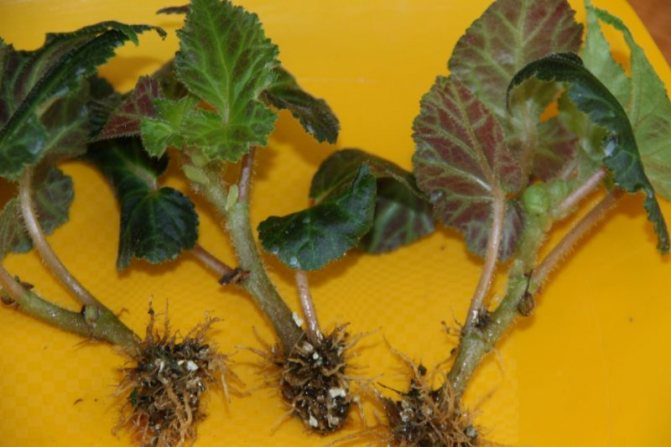

The main methods of breeding begonias:
- stem cuttings;
- seeds;
- dividing the sheet;
- dividing the rhizome;
- dividing the tubers.
Cutting is suitable for all types of begonias and is the easiest and most convenient way to propagate.
To do this, follow these steps:
- Cut the cuttings 10 cm long with a sharp knife, so that on each there are 2-3 leaves.
- You can place the workpieces in clean, settled water until roots form. After, they are planted in a pot prepared with soil.
- It is allowed to plant the cutting immediately in a container with soil. Then you need to cover it with polyethylene on top.
- After new leaves appear, the bag is removed and the stalk is transplanted to a permanent place.
The propagation method using leaf division is suitable if you need to get more planting material.
- To do this, a large sheet is cut with a sharp knife into several parts so that each has a central vein.
- After dividing, the pieces should be placed in a box on top of the soil, slightly pressing down. You can deepen them a little into the ground.
- From above, the box is covered with foil or glass. Daily ventilation is carried out.
- When the seedlings take root, they are transplanted to a permanent place.
The seed method is more troublesome. Sowing must begin at the beginning of February, so that the seedlings have time to grow and get stronger by the winter period.
- First, boxes with soil are prepared, on the surface of which the seeds are evenly distributed.
- Sprinkle them on top with a thin layer (about 0.2 cm) of earth.
- The boxes are covered with foil or glass.
- Every day, you should moisten the soil with a spray bottle, so as not to "wash" the seeds, and also to ventilate them.
- When shoots appear, the film must be removed.
To propagate a flower by dividing the rhizome, it is necessary to remove it from the ground, divide the roots into several parts with a sharp knife and plant them in containers prepared with the ground. And for tuberous species of begonias, the method of reproduction by dividing the tubers is suitable. It begins with the onset of spring. The tuber must be cut into several parts so that each has 1 bud. Pieces of tuber are planted in separate pots.
Flower pot size
One of the important conditions for budding and foliage growth is the volume of the pots. Small plants, as they grow, need to be transplanted gradually to a larger volume. Do not feed until we can provide the required amount of light and heat. Heat should be above 20 degrees, and daylight hours at least 14 hours. Pelargonium growing on a window does not require a large pot volume. If it does not correspond to the development of the root system, it is useless to wait for flowering. Planting in a large pot will negatively affect the flower, it will constantly grow roots to fill the empty space.
Nitrogen fertilizing
The soil must be absolutely neutral, air and moisture resistant. Placing the drainage in small pots is optional. As a soil, chernozem with humus in a ratio of three to one is ideal. Why only put one piece of humus? Because a large amount of nitrogen is unacceptable. Otherwise, the flower will not delight with its lush flowering. Do not plant pelargonium in commercial peat extract. It is better that the composition always contains rich black earth.
Be sure to feed geraniums with a complex fertilizer. In the composition, the presence of trace elements is mandatory, the most important of which is magnesium. We select the fertilizer correctly, potassium and nitrogen should be in equal proportions. Pelargonium is very fond of feeding with ash, often it is not necessary to do it, but it is necessary 2 times a season.
How does begonia bloom?
What to do after begonia has faded?
After the plant has pleased you with lush flowering, it, without touching the roots and stems, definitely worth drying... We put in a darkened place for a month so that all the nutrients from the stems and roots go into the tuber. We dig it out 15 days after the upper part of the begonia that is on the surface has finally died out.
Do you need to prune begonias after flowering?
After the flowering stage is completed, the plant needs pruning. At the same time, the stems are cut... This is necessary so that the flower gains strength and nutrients and has the opportunity to thank its mistress in the future with a magnificent and fragrant bouquet of terry begonia inflorescences.
Diseases, pests and problems in the cultivation of begonia Elatior
Under the right conditions and good care, Elatior begonias never get sick. They are much more resistant than all flowering begonias. In fact, they can only suffer from rot due to inaccurate watering and dampness.
When taken out into the garden or placed on balconies, Elatiors often suffer from powdery mildew. Fighting with fungicides on flowering begonias is useless, it is better to destroy the affected bushes as soon as possible. Occasionally, in the open air, plants are also threatened by aphids, which are best dealt with with insecticides.
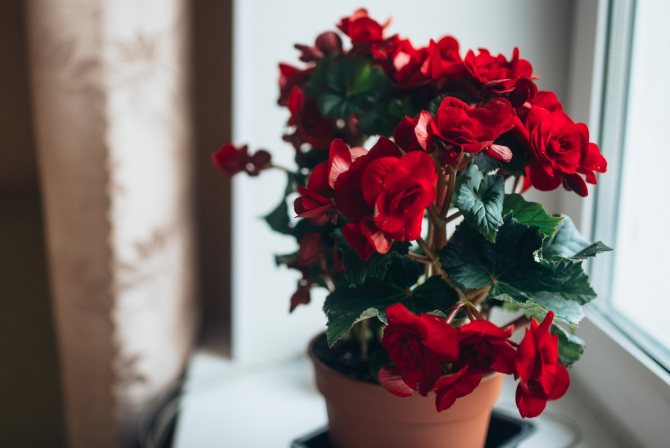

Under the right conditions and good care, Elatior begonias never get sick.
What elements does begonia need for abundant flowering?
Begonias grow actively from March to October, then they lose their leaves and "hibernate." At this time, all shoots are cut from the plant, the tubers are placed in wet sand and stored until spring in a dark, cool place, maintaining moderate humidity.
In March, begonias are planted in a pot, shoots should appear immediately. At this time, the first nitrogen fertilization is given (saltpeter, urea). In the future, flowering plants should not be fed with nitrogen means, otherwise begonia will give abundant foliage instead of flowers. Suitable fertilizer for flowering begonia - special complexes for indoor plants with a predominance of potassium. Nitrogen fertilizing is suitable for leaf varieties.
The lack of nutrients can be recognized by the appearance of the plant.
| Element | Deficiency sign |
| Potassium | The edges of the leaves turn yellow and the flowers die off |
| Phosphorus | Growth slowed down |
| Calcium | The plant has become susceptible to disease |
| Iron | Pale color of leaves |
Begonia also requires magnesium, boron, manganese and zinc. These elements are present in a balanced amount in ready-made mineral complexes for indoor plants.
Refractory begonia diseases
There are diseases, the treatment of which does not give results, the flower disappears. It is better to remove the affected plant so that the infection does not spread further.
Chrysanthemum diseases
Ring spot - a virus that lives in cells, it is difficult to get rid of it, since it persists in the tubers, and after a while it appears again. Light green-yellow spots and strokes appear on the leaves, which turn into bronze, dead areas appear. Blooming begonia flowers turn black. The only way out is to destroy the diseased plant.
Note! Insect pests are carriers of pathogens. It is necessary to follow and, when they appear, immediately proceed to destruction. Prevention will help eliminate insects and keep green pets healthy.
Bacterial spotting is manifested by the appearance on the underside of the leaves of small watery specks, which eventually darken, acquire a brown tint and spread to the entire begonia.
The flower must be destroyed, the pots and soil must be disinfected.
Prevention: treatment 2 times with a 0.5% suspension of copper oxychloride at intervals of half a month.
Cucumber mosaic is a virus that causes the leaves to become covered with ring-shaped and round yellow spots, followed by their deformation. There is no way to get rid of the disease. The virus spreads very quickly, actively capturing the entire flower. Having discovered, the source of infection is immediately eliminated.
Dormant period and awakening of tubers
The period of rest or hibernation in ever-flowering begonia starts in November and lasts until early spring... With this event, the plant is hiding from the cold. The main task of flower growers during this period is to preserve the tubers and protect them from drying out.
If the flower is sent for storage early, she may not have time to get ready for bed, since the supply of nutrients at this moment will be insufficient. therefore do not rush and remove the flower at the very beginning of autumn... The optimal time is late October - early November. The main thing is to be in time before the onset of freezing.
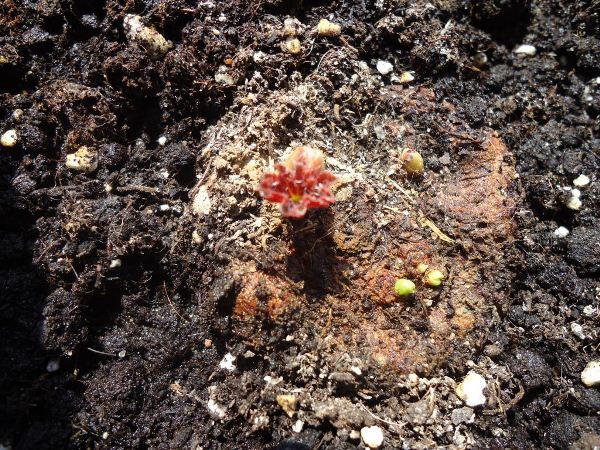

Tuberous begonia awakening after wintering
With the onset of heat, namely in March - April, the buds of the flower swell and the flower comes out of the state of sleep. At this time, it is necessary to carry out cuttings and plant in a peat mixture.
The tubers should be planted so that their top looks up. It is usually concave or flat, with kidneys. For germination, you need warmth, not lower than 18 degrees, and daily watering... The first shoots will appear in a few weeks.
Tubers can be divided, the main thing is that on each part of them there are several buds. The place of the cut is processed with ash or charcoal. It is advisable to treat the places of cuts with charcoal.
It is recommended to plant sprouted flowers in open ground in early summer.... The place for this should be sheltered from the wind, with fertilized soil. Direct sunlight should also not hit the flower.
Difference between wintering begonia at home and outdoors
Caring for tubers of home and garden plants is significantly different. To properly prepare them for winter, you should take into account some of the features of both.:
- Outdoor Begonias much larger than those that grow in pots in the house. Garden flowers should be removed at the onset of the first hard frosts. The rule of the golden mean is important here, since the first light frosts are not able to kill the plant, so there is no need to rush either. Let the flower gain strength and prepare for hibernation on its own. The optimal time is when the leaves and stems of the plant will die off by themselves. After that, the stems are trimmed, and the tubers themselves are placed in a box and left so that they can dry out. After that, containers with plants are removed for storage until spring.


Begonia tubers are dug up for the winter and placed in a box
- Caring for a home plant in winter looks a little different.... The tubers are not dug out, but remain in their pots. At the first appearance of wilting of the stems, they are also cut off. Watering from this point on is reduced to a minimum. In the spring, Begonia is necessarily transplanted into new soil, having previously divided it into several parts, if many buds have formed on them.
It is not uncommon when homemade Begonia does not shed its leaves for the winter and remains green. In this case, you do not need to trim it. The plant remains in place until the spring transplant.
Pest and disease control
Indoors, like many plants, begonia can be exposed to diseases and pests.
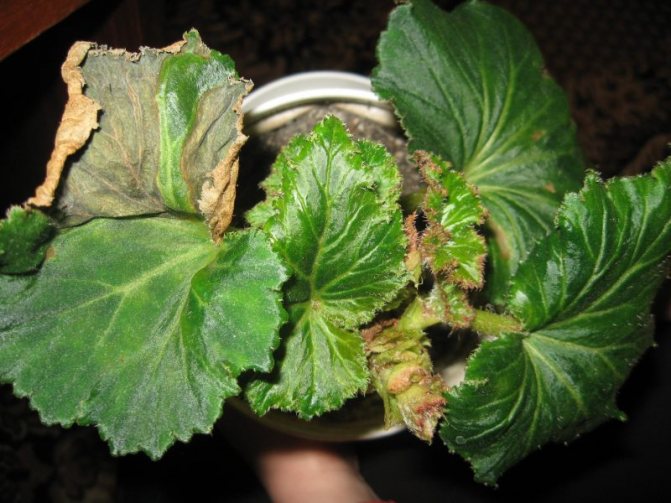

The most common diseases are:
- gray mold;
- powdery mildew;
- root rot.
In the fight against diseases, it is necessary to treat the plant with fungicides, reduce humidity and reduce the amount of watering.
The main pests include:
- whitefly;
- false shield;
- spider mite;
- aphids;
- nematodes;
- thrips.
When pests appear on the bush, it is necessary to treat it with insecticides and remove all affected parts. Otherwise, you will have to get rid of the flower so that the pests do not colonize healthy plants.
Excessive watering
If you keep the soil moist all the time, then there will be no flowering. Water well so that the lower roots get enough moisture. After watering, it is necessary to completely dry out the soil. Thanks to this, a huge variety of colors will be laid. The more side shoots there are, the more lush the flowers will bloom. The smallest plants do not need to be overdried at an early stage, only after they grow up and take root.
In winter, pelargonium needs rest.She does not need a lot of light, rare watering is carried out, you can put it more densely, close to each other.
If the geranium was able to rest in winter, the spring-summer bloom will be abundant and lush. Now, knowing some of the rules and features of its breeding, anyone can handle it.
- the volume of the pot for an adult geranium should be a maximum of 7 cm in diameter;
- transplant as needed;
- light and warmth are prerequisites;
- the soil should be nutritious with a small amount of nitrogen;
- complex fertilizers and feeding with a high potassium content, with a full set of microelements, subject to 14 hours of light;
- do not keep geraniums constantly wet, take breaks.


Every begonia grower wants it to look healthy and bloom luxuriantly. This is only possible with proper care. In this article, we will tell you how and how to feed begonia, what growing conditions it prefers.
The plant sheds buds: reasons
Begonia is a very unpretentious plant, and often flower growers are faced with such a problem when the buds of the plant begin to fall off. Why does this happen in a plant? There may be several reasons, and not all of them can be easily identified.
The main reasons for the dropping of buds in begonia:
- the plant got water;
- the air in the room is too dry;
- drafts;
- waterlogging or insufficient watering (how and with what to water begonia?);
- direct sunlight;
- depletion of the soil;
- diseases and pests;
- moving a flower from one room to another.
Preventive measures
To avoid falling buds of begonias, it is necessary to regularly ventilate the room.... You should also avoid too low temperatures, monitor the frequency of watering, prevent thrips and aphids on the plant, and from time to time spray the plant with auxiliary substances such as a five percent suspension of copper oxychloride.
Thus, begonia is a grateful flower if properly cared for. You can find out more tips for caring for a houseplant here. When growing decorative deciduous varieties, you can achieve the creation of whole green corners, where the beauty of begonia leaves will manifest itself in full force. And bright and densely blooming specimens will bring extraordinary colors into your life and will give you many unforgettable pleasant moments. To create such beauty, you can use varieties such as "Women's Weapon", "Burning Passion" and "Men's Flowers". We talked about these species in more detail in this article.
Tuberous begonia curls the leaves. What is it? Help!
Hello, dear members of the forum! Your help is very necessary. For the first time I bought begonias tubers, in their cultivation I am still an amateur. At first everything was good, they grew juicy and strong. And then they began to roll the leaves like this. The reason is not clear to me. At first I thought it was dry at home and put a bowl of water between the pots and sprinkled it on the glass of the window where the begonias were. The result is zero. Then I decided that they were burning in the sun, although the window was west, and even the trees a couple of meters from the window. But just in case, I tried to rearrange it a meter from the window - they stopped growing and began to reach for the light. I did not find any pests on the leaves or in the soil. Just in case, I treated it against fungus and pests - zero reaction. Moreover, the leaves remain juicy and elastic, when you try to expand to the end, they break. Recently I discovered that on one begonia, the leaf seemed to break from twisting and dry around the edges of these holes (see photo). And so - no spots, plaque, insects, cobwebs, dots, etc. I water as the soil dries up, drainage is good, I do not pour water on the tuber (I water it along the edge of the pot). The temperature in the room is 18-25 C And what is more interesting, young leaves grow constantly, and they do not grow twisted, but begin to curl at the earliest - in a week. This is definitely not a feature of the variety - the varieties are different, but from the same manufacturer.
forum.
How to feed begonia for lush bloom
What to do for the abundant flowering of begonia? It's very simple: if you want to see these plants blooming, you need to add useful elements at home. Usually, to make the plants bloom, they are fed with begonia fertilizers, which contain potassium and phosphorus. Feeding for begonias can be chosen in specialized stores, where you will always be prompted with a product that will suit your flower.


The most popular dressings for these flowers, which can be easily applied at home, are Begonia and Good Power. Before proceeding with fertilizing, it is necessary to add a weak solution of potassium nitrate to the soil for begonia.
And remember that after flowering, do not disturb the flower. There is no need to try to make this beauty bloom again when it is already entering a state of rest. On the contrary, you should take care of her, and at home provide her with the care she needs right now. It is recommended to gradually stop adding nutrient mixtures to the soil mixture from the end of August.
Fertilization rules
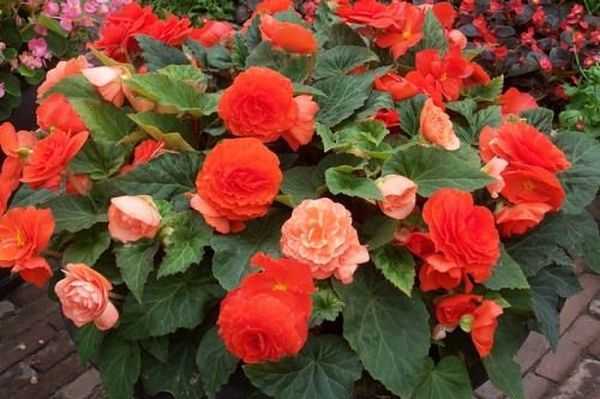

So how do you fertilize this beauty at home? For everything to go smoothly, you need to take into account the factors that will contribute to the success of this procedure.
The first factor is compliance with light and temperature conditions. These colors need a fair amount of light. They also need warmth and the absence of sudden changes in temperature. All this will contribute to the early assimilation of dressings.
The next thing to consider is the time of day. The best time is evening, when it is already dark. It is better to refrain from carrying out the procedure during the day.
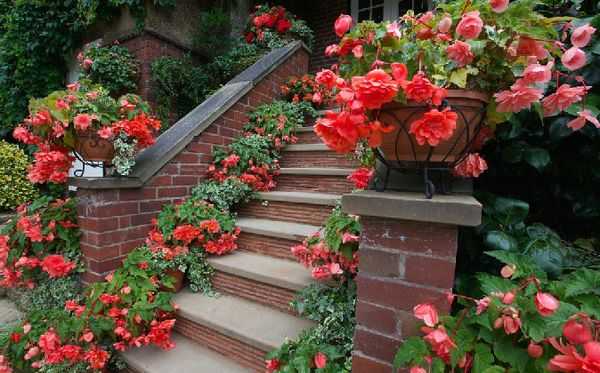

Remember that in order for the land in which begonia grows to quickly absorb the necessary elements, it is recommended to thoroughly moisten the soil before applying them. The optimal time is a few hours before the procedure.
An important point: the fertilizer itself should in no case come into contact with the plant, otherwise it is fraught with troubles, like chemical burns.
The last and perhaps most important rule: don't overdo it. It may seem to some that the more fertilizer you apply, the greater the effect will be. The effect will really not be long in coming, but it will be completely opposite to what you expected. Excess fertilizer is very harmful to the flower, so in order for the roots and tubers of your pet to be in order, add only the necessary amount of nutrients, and no more!
Video "How to care for begonias and apply top dressing"
In this video, you will learn how to care for begonias and feed the plant.
grow-
Fertilization rules
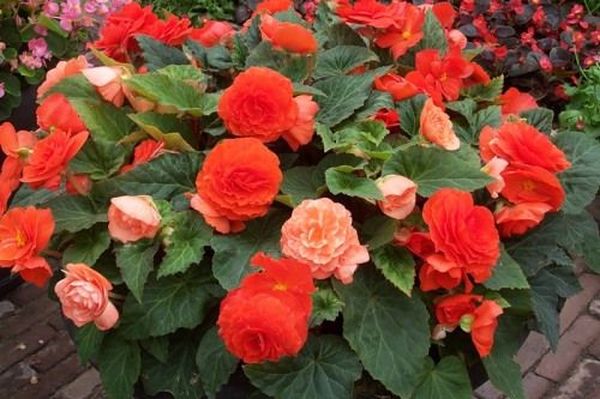

So, how do you fertilize this beauty at home? For everything to go smoothly, you need to take into account the factors that will contribute to the success of this procedure.
The first factor is compliance with light and temperature conditions. These colors need a fair amount of light. They also need warmth and the absence of sudden changes in temperature. All this will contribute to the early assimilation of dressings.
The next thing to consider is the time of day. The best time is evening, when it is already dark. It is better to refrain from carrying out the procedure during the day.


Remember that in order for the land in which begonia grows to quickly absorb the necessary elements, it is recommended to thoroughly moisten the soil before applying them. The optimal time is a few hours before the procedure.
An important point: the fertilizer itself should in no case come into contact with the plant, otherwise it is fraught with troubles, like chemical burns.
The last and perhaps most important rule: don't overdo it. It may seem to some that the more fertilizer you apply, the greater the effect will be.The effect will really not be long in coming, but it will be completely opposite to what you expected. Excess fertilizer is very harmful to the flower, so in order for the roots and tubers of your pet to be in order, add only the necessary amount of nutrients, and no more!
Features of the
Begonia has heterosexual flowers: there are female flowers with pistils, and male flowers with stamens. How to tell them apart:
- On the back of the flower, female flowers have a bulge - the future seed capsule, male flowers have nothing there.
- Terry flowers in the corresponding species can only be male, female double flowers are not. But male flowers, at the same time, can be simple.
- If you understand what pistils and stamens look like, you can just make out them. By the way, some double male flowers can be without stamens at all. It is the modified stamens that make the flower terry.
Wintering features of First-Year Tuberous Begonias
In the first year of life, Begonia tubers are small and weak, therefore they need special care. If they are kept together with adult plants for the winter, there is a chance that the first years will die.
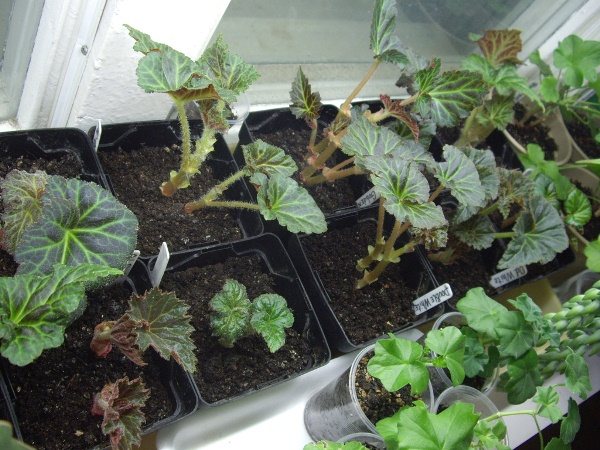

In winter, tuberous begonias enter a dormant period, which usually lasts from November to February.
Young tubers are removed from the garden and placed together with an earthen lump in boxeswhere a mixture of peat has already been prepared. The peculiarity of first years is that their rest period is a relative concept. Often their upper part (stems and leaves) remains green for the winter. Therefore, flowers in boxes are placed in a light and cool place. Watering at this time is required infrequently. It is enough to slightly moisten the soil once or twice a month. In the spring, the plant again enters the stage of active growth. In April, they should be transplanted first into pots of peat, and then, closer to summer, planted in the ground.
In the second year, the plant is already independently and consciously preparing for hibernation, and this time in the fall by October, his upper the part that must then be cut off.
Begonia - the nuances of growing
In the first days after buying a plant, you need to pay more attention to it so that it decorates the house and has a healthy look for several years.
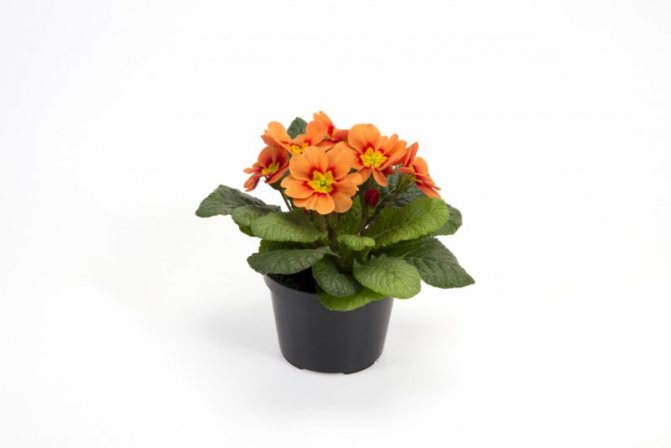

To grow begonias at home, you should adhere to some rules and nuances:
- Create favorable conditions for the active growth of the flower.
- Try to protect it from drafts and wind.
- Provide optimal environmental parameters in winter.
- Try to find a suitable place for the flower so as not to disturb it.
Important! It is not recommended to purchase begonia and transplant it in the winter. She may not survive and die during transplantation from a shipping pot.
What do you need for abundant flowering?
Phosphorus promotes the formation of flower buds, abundant and long flowering. It is after a period of active growth, during the budding period, that potassium-phosphorus fertilization should be carried out in the complex. At this time, the dose of potassium salts should not exceed 1.5 grams per 1 liter of water.
Note! An ideal means for replenishing phosphorus needs will be phosphorite flour, it must be poured into the soil to the begonia, at the rate of 70 grams per 1 square meter of soil.
Indoor plant transplant
It is necessary to repot the plant as the root system pot is filled. Begonia has no special requirements for the soil. You can buy ready-made soil or prepare it yourself. To do this, mix in equal parts leafy earth, sand, peat and humus.
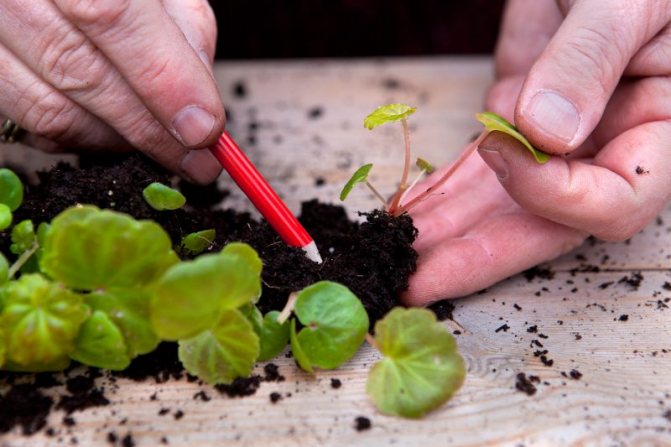

- The pot must be selected larger than the previous one in size by 3-4 cm in diameter. At the bottom, it is necessary to organize good drainage so that moisture does not accumulate there and the roots do not rot.
- It is better to transplant with the arrival of spring. The frequency of transplants is once every 2-3 years.
- Before the procedure, the flower should be shed well to make it easier to remove it from the ground.
- Remove excess soil from the roots and remove damaged parts.
- To prevent diseases of the root system, you can place the plant in a weak solution of potassium permanganate for 30 minutes.
- In a new container, you need to carefully place the plant without damaging the roots. Sprinkle lightly with earth and compact.
The first month after the begonia transplant, more attention should be paid. Provide more light, abundant daily watering and a temperature of 22-23 degrees. It is advisable to observe special conditions until the plant takes root and begins to grow actively.
Frequent transplants
Transplanting for geraniums, as for any home plant, is stressful. We carry out this procedure as needed, 2-3 times a year, preferably in the spring. An unscheduled transplant may be required in the following cases:
- the root system does not fit in a cramped pot, the plant lacks nutrients;
- high soil moisture provokes root rot;
- depletion of the soil causes dropping of buds and weak formation of ovaries;
- exposing the stem, the lower leaves fall;
- the need for plant propagation by dividing the rhizome.
Pelargonium loves to loosen the soil, but this must be done carefully, to a depth of no more than 5 centimeters.
The only danger to the flower is the wrong transplant. The soil should be poor and light. We take three parts of garden soil and one sand, always with the addition of ash 1 tbsp per liter. Insert a stalk into dry ground, the volume of the ground is 150 ml for one shoot. Watering is moderate during the entire rooting, the water is warm. Geranium is afraid only of the "black leg", which is formed when the wet soil and the stem come into contact.
There is a little secret, if you sprinkle a little dry sand on top and sprinkle with ash, then there will be no "black leg", and the plant will successfully root.
If possible, we create warmth for the roots for 2 weeks.
The main methods and conditions of storage in winter
There are several methods for storing such plants.
The most common way is in the basement... Dried Begonia tubers are laid out in boxes or wooden boxes. Fall asleep on top with sifted sand and put it in the basement. You can make a mixture of sand, peat and sawdust in equal amounts. This method is convenient for a large amount of planting material.
From time to time it is necessary to sort out and remove the rotten ones.
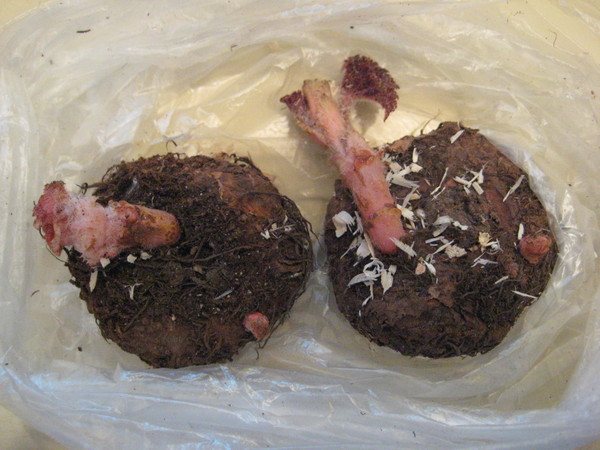

You can store begonia tuberous material in boxes filled with peat and sand, or in a refrigerator in a plastic bag filled with peat, moss or sawdust
The second, no less popular way of storage is in an apartment.... The best place would be an area near a balcony door or under a window. There are two types of storage in the house:
- In the boxwhen the tubers are placed in them and covered with sand and sawdust.
- In pots... Flowers that grew in a pot remain in it, are cut and transferred to a cool place. In this case, the plant should be watered no more than once a month.
In the spring, after germination, they are transplanted into new soil.
The third way of storage is in the refrigerator.... Suitable for small amounts of planting material. For this, Begonia tubers are placed in plastic bags with sawdust, after having made holes in them for breathing.
The bags are placed in the bottom drawer of the vegetable refrigerator.
Compliance with all of the above storage rules guarantees successful growth and flowering of Begonia next season.


Begonia is the favorite of many women, having a varied flower shape and a luxurious palette of their shades.
The magical beauty of flowering is its main advantage.
Preparing tubers for storage
The result of storage and further growth depends on how correctly the planting material will be prepared for winter and how you will take care of this plant.
Firstly, Begonias that grow in the garden must be dug out before the first hard frosts.... At this time, the upper part of the plant is cut off, while leaving hemp at least 1 centimeter in size.
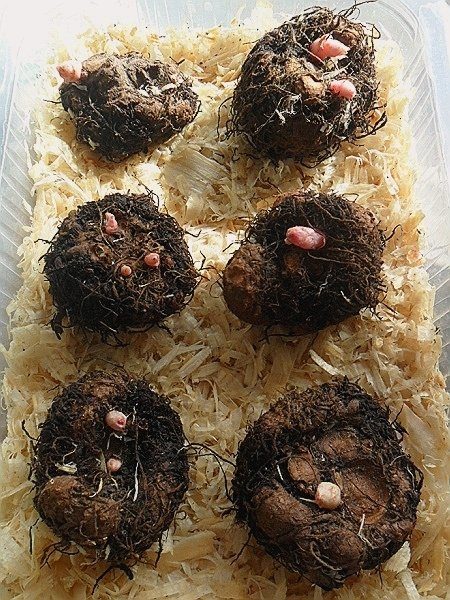

Dry the begonia tubers before storing.
Secondly, the tubers are harvested in a dry and cool place, where they should dry out. Only after they are completely dry can it be put away for storage.
Begonia that grows at homeis stored differently. Preparation for hibernation begins in October. First, watering is reduced, after a month, it is completely stopped. When the top of the flower withers, it is cut off. If it does not die off, it is left in the same state.
Compliance with storage rules is the key to successful wintering and further growth in the future.

